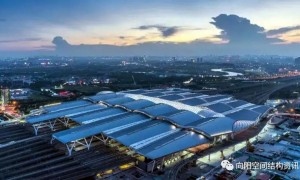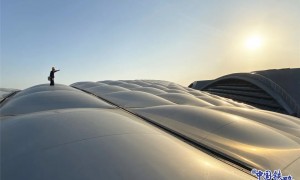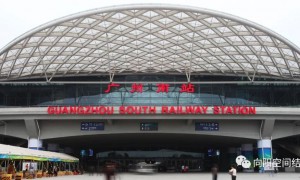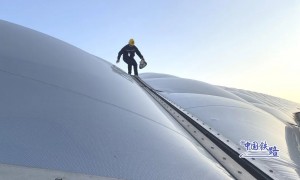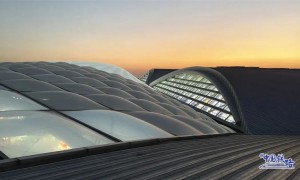Infill walling
填充墙
Infill walling is the generic name given to a panel that is built in between the floors of the primary structural frame of a building and provide ssupport for the cladding system. Infill walls are considered to be non-load bearing, but they resist wind loads applied to the façade and also support their own weight and that of the cladding. Light steel walls using C sections are increasingly used as infill walling within both steel and concrete framed buildings, and have largely replaced masonry or timber alternatives.
填充墙是建筑主要结构框架的之间的面板的通用名称,并为装饰层系统提供支持。填充墙被认为是无负荷的,但它们能抵抗施加在立面上的风荷载,还能支撑自身和覆层的重量。使用C型钢的轻质钢墙越来越多地应用在钢结构或混凝土框架建筑的填充墙,并在很大程度上取代了砖石或木材替代品。
An important feature of light steel infill walls is that the size and thickness of the light steel C sections can be varied depending on the height of the façade wall and the wind loads acting on it. Large windows, parapets and other architectural features are made possible. Infill walls are generally installed onsite as individual elements that are pre-cut to length but they can be pre-fabricated as large panels with the cladding already attached.
轻钢填充墙的一个重要特点是,轻钢C型钢的尺寸和厚度可以随立面墙的高度和作用在其上的风荷载而变化而调整。大窗户、女儿墙和其他建筑特征成为可能。填充墙通常在现场作为预先切割的单个构件安装,但也可以预制成带有包层的大型面板。
The same components may be used for internal separating walls, but here the main issues are fire resistance and acoustic insulation rather than resistance to loading. A nominal internal pressure is used in the design of internal separating walls.
同样的组件也可以用于内部分隔墙,但这里主要的问题是防火和隔音,而不是耐荷载。内隔墙的设计采用公称内压。
Contents目录
1 Types of infill walling填充墙的类型
1.1 Light steel framed infill walls轻钢框架填充墙
1.2 Light steel separating walls轻钢隔墙
1.3 Masonry infill walls砖填充墙
1.4 Concrete infill walls混凝土填实墙
1.5 Timber framed infill walls木框架填充墙
2 Benefits of light steel infill and separating walls轻钢填充墙和隔墙的优点
3 Performance requirements for infill walls填充墙的性能要求
3.1 Thermal performance热工性能
3.2 Acoustic performance隔声性能
3.3 Fire resistance耐火性能
3.4 Weather resistance耐久性能
3.5 Wind resistance抗风性能
4 Cladding systems and interfaces装饰面系统和接口
4.1 Infill walls supported by beams or floor slab由梁或楼板支撑的填充墙
4.2 Infill walls supporting external leaf of brickwork支撑外侧砌筑单砖饰面的填充墙
4.3 Infill wall supporting light weight cladding支撑轻质覆层的填充墙
5 Performance requirements for separating walls隔墙的性能要求
5.1 Acoustic performance隔声性能
5.2 Fire resistance of separating walls隔墙的防火性
5.3 Load resistance of internal walls内墙的抗载荷能力
6 References参考文献
7 Further reading扩展阅读
8 Resources鸣谢
9 See also
10 External links
Light steel infill walls in a steel framedresidential building, Southampton
轻钢填充墙在钢框架住宅建筑,南安普敦
1 Types of infill walling
填充墙的种类
Various forms of construction can be employed to create infill walls that span between floors in steel or concrete buildings. Traditionally, infill walls used masonry or timber, but the modern form of constructionuses light steel C sections that span between the floors and around openings.The C sections are placed at a regular spacing depending on the external façade materials, and at a spacing which is also compatible with standard plasterboard and sheathing board sizes.
在钢或混凝土建筑中,可以使用各种形式的建筑来创建跨越楼层之间的填充墙。传统上,填充墙使用的是砖石或木材,但现代的建筑形式使用的是轻质钢材——这些钢材横跨地板和开口周围。C型钢根据外立面材料的不同,以规律的间距放置,间距也与标准石膏板和各种胶合板的尺寸相匹配。
1.1 Light steel framed infill walls
轻钢龙骨填充墙
In multi-storey framed construction, it is now common practice to use light steel infill walls to create a rapid dry envelope to support the external cladding. The same form of construction may be used as separating or compartment walls between different parts of the building. The use of light steel infill walls may be applied to steel or concrete framed construction.Light weight, speed and ease of installation are important constructional benefits that have led to the rapid increase in use of this form of construction.
在多层框架结构中,现在常用的做法是使用轻钢填充墙来创建一个快速干法施工的面板来支持外部包层。同样的结构形式也可用作建筑物不同部分之间的分隔墙墙。轻钢填充墙的使用可以适用于钢或混凝土框架结构。重量轻、速度快、安装方便是其重要的建筑优点,导致这种建筑形式的使用迅速增加。
The light steel components used in infill walls consists of C sections and U sections of 75 to 150 mm depth that are cold roll-formed from galvanized steel strip of 1.2 to 3.2 mm thickness specified toBS EN 10346[1]. The galvanizing (zinc layer) provides excellent durability. The C sections are placed at 400 or 600mm spacing and pairs of C sections may be used next to large openings.
填充墙中使用的轻钢构件由深度75至150毫米的C型钢和U型钢组成,由厚度1.2至3.2毫米的镀锌钢带冷轧成型,规格满足EN10346。镀锌层提供了优异的耐久性。龙骨间距在400或600mm,成对的龙骨可以使用在门窗等大开口位置。
Wall panels can be pre-fabricated as storey-high units or, more often, are site assembled from C sections that are delivered cut-to-length. The second approach is often the only solution in renovation applications where tolerances in the original construction have to be accommodated.
墙板可以预制成一层楼高的单元,或者更常见的是龙骨按长度分段组装而成。第二种方法通常是唯一的解决方案,尤其是在改造类项目的应用中,因为这类项目必须考虑到公差较大等各种因素。
Site assembled light steel walls in a steel framed building
在一个钢框架建筑中组装轻型钢墙
Pre-fabricated light steel infill wall panels in a steel framed building
钢框架建筑中的预制轻钢填充墙板
Infill walls consist of a bottom ‘track’ attached to the floor and a top‘track’ attached to the underside of the floor above. The top track is a U section and allows for sliding of the vertical studs and height adjustment. This movement is essential in concrete frames, where 2 to 3 mm shortening of the concrete structure per floor can occur over time as well as normal structural movements.
填充墙由连接到地板的底部“轨道”和连接到上面地板底面的顶部“轨道”组成。顶部轨道是一个U型部分,允许竖向龙骨滑动和高度调整。这种滑动在混凝土框架中是必不可少的,每层混凝土结构缩短2到3毫米的时间可以发生,以及正常的结构运动。
The vertical C sections are designed to span 2.4 to 5m between floors, and to resist wind loads or other loads in bending. The horizontal C sections above and below the windows transfer loads back to the vertical C sections.
龙骨部分的竖向设计高度为2.4 ~ 5米,能够抵抗风荷载或其他弯曲荷载。在窗口上方和下方的水平龙骨将荷载传递回垂直龙骨部分。
One or two layers of ‘fire-resistant’ plasterboard (conforming to BS EN520[2], Type F) to the internal face provide for up to 90 minutes fire resistance to the light steel infill wall.
内表面有一层或两层防火石膏板(符合BS EN520,F型),对轻质钢质填充墙的耐火时间可达90分钟。
1.2 Light steel separating walls
轻钢龙骨隔墙
Light steel separating walls use similar components to light steel infill walls and are used to provide acoustic separation and fire compartmentation between occupancies or distinct parts of the building. For both of these functions, double layers walls are generally specified in order to achieve the required acoustic attenuation between occupancies.
轻钢隔墙采用与轻钢填充墙类似的构件,用于在建筑物的房间或不同部分之间提供隔音和防火分隔。对于这两种功能,一般都规定双层墙,以实现单元之间所需的隔声量。
The structural loading for internal walls is relatively low and is generally considered to correspond to an internal pressure of 0.5 kN/m².The C sections are generally much thinner than in external walls(typically 0.9mm thick) and gain some benefit of the stiffness of the plasterboard fixed on the outside. Because these walls are non-loading bearing,two layers of plasterboard would generally achieve the required acoustic insulation and 90 minutes fire resistance.
内墙的结构荷载相对较低,一般认为对应的内压为0.5 kN/m。龙骨通常比外墙要薄得多(通常为0.9mm厚),并获得了固定在外面的石膏板的刚度的一些好处(蒙皮效应)。由于这些墙体是不承重的,两层石膏板一般可以达到要求的隔音和90分钟耐火。
Partitions are not required to have acoustic or fire functions and so are single leafwalls comprising C sections of 55 to 90mm depth, depending on the wall height, with single layers of plasterboard on each side.
对于不需要具备隔音或防火功能的隔墙,一般单层石膏板隔墙就够了,单面石膏板隔墙根据墙体高度的不同,由55至90毫米深的C段组成,每一面都有单层石膏板。
Pre-fabricated light steel wall panels
预制的轻钢隔墙
1.3 Masonry infill walls
砌筑填充墙
Walls constructed from clay bricks or concrete blocks are the traditional form of infill wall construction. However, the use of block-work infill walls has reduced in recent years because it is a messy and time consuming site operation, and requires a large amount of materials handling. From a design point of view, strengthening posts are required next to large window openings,as the masonry is not sufficiently strong to resist the high local windloads next to these openings.
由粘土砖或混凝土砌块构成的墙体是填充墙的传统形式。然而,近年来,砌块填充墙的使用减少了,因为它是一个混乱和耗时的现场操作,需要大量的材料处理。从设计的角度来看,由于砌体的强度不足以抵抗大窗孔附近的局部风荷载,因此需要在大窗孔附近设置构造桩。
1.4 Concrete infill walls
混凝土填充墙
Concrete infill walls are generally in the form of large precast concrete panels that are storey high and often of a width dictated by the column spacing. These large panels may be top hung or bottom supported. They typically bear onto the floor slab using a boot arrangement,and are bolted back to the structure on the level above or below.Integral panels may be clad in other materials (typically concrete panelsare clad in stone).
混凝土填充墙通常是大型预制混凝土板的形式,层高和宽度往往由柱间距决定。这些大面板可以是上悬或下支撑。它们通常通过一个引导装置支撑在楼板上,并通过螺栓固定在上下一层的结构上。整体面板可以覆以其他材料(典型的混凝土面板覆以石材)。
Panel weights of approximately 300kg/m² are typical, with panel widths of between 3 and 9m and height of 3.5 to 4.2m. The maximum size of panel is restricted by transport considerations and crane lifting capacity (both on site and at the concrete works). 15 to 20 tonnes are typical maximum weights of precast concrete panels.
典型的面板重量约为300kg/m,面板宽度为3 ~ 9m,高度为3.5 ~ 4.2m。面板的最大尺寸受运输考虑和起重机起重能力的限制(现场和混凝土工程)。预制混凝土板的最大重量一般为15至20吨。
Pre-cast concrete infill wall panels
预浇铸混凝土填充墙板
1.5 Timber framed infill walls
木框架填充墙
Timber infill walls use standard timber sections of 90 and 140mm depth to span 2.4 to 3.6m between floors and are similar in form to light steel infill walls. Timber sections are cut to length and are placed at 400 mm or 600 mm spacing. The disadvantage of timber in comparison to steel is that it is not as strong and it is not possible to use it in tall walls or in walls with large openings.
填充墙采用90毫米和140毫米深度的标准木龙骨,层高2.4米至3.6米,其形式与轻型钢填充墙相似。木龙骨按长度切割,放置在400毫米或600毫米间距。与钢相比,木材的缺点是不那么坚固,不可能用在高大的墙壁或有较大开口的墙壁上。
Steel infill walling
轻钢龙骨填充墙
2 Benefits of light steel infill and separatingwalls
轻钢龙骨墙体的优点
The benefits of light steel infill walls (used externally) and as separating walls (used internally) are:
轻钢填充墙(外部使用)和作为分隔墙(内部使用)的好处是:
Speed of construction
建造速度快
Rapid installation of the light steel infill walls creates a weather-tight envelope allowing other activities within the building to proceed much earlier than would be possible with block-work infill walls.
轻钢填充墙的快速安装创造了一个耐候性的围护结构,允许建筑内的其他活动比砌块填充墙进行得更早。
Minimum material use and less handling on site
节约材料,施工效率高
Fewer materials and less labour to lift and move materials are required,as light steel framing consists of either pre-fabricated wall panels, or assemblies of light weight C sections that are designed to span between the floors. The construction process is ‘dry’ so that shrinkage and other drying-out problems are eliminated. Time savings of over two weeks per floor are readily achievable.
更少的材料和更少的劳动力来提升和移动材料是必需的,因为轻钢框架要么由预制墙板组成,要么由重量较轻的C段组装而成,这些C段设计用于跨楼层。施工过程是“干燥”的,这样就消除了收缩和其他干燥问题。节省两周以上的时间是很容易做到的。
Waste is almost completely eliminated by use of cut-to-length Csections.
Tall walls up to 5 m subject to high wind pressures
高达5米的高墙能承受强风压力
Light steel external walls resist wind loads of up to 2kN/m2.These pressures may occur in tall buildings, or at corners due tolocal wind pressure. Typically 100mm C sections studs are used at 400mm centres, which can span up to 3.6m between floors. In regions of high wind pressure, or for taller walls, 150mm C sections studs maybe used. For internal applications, wall heights of up to 7m can be achieved,such as in auditoria.
轻钢外墙可承受高达2kN/m2的风荷载。这些压力可能发生在高层建筑,或在角落由于局部风压。典型的100mm C型钢按400mm的龙骨间距,两层之间的跨度可达3.6米。在高风压地区,或对于较高的墙体,可以使用150mm C截面龙骨。对于内部应用,墙壁高度可达到7米,如在礼堂。
Light weight
轻
Light steel walls are much lighter and thinner than conventional block-work walls and do not apply heavy line loads to the floor. The typical line load from a light steel wall with light weight cladding is 2kN/m, which is less than 30% of that ofa block-work wall. This is often crucial in refurbishment applications where the quality of the original floor construction is not sufficient to resist heavy loads.
轻钢墙比传统的砌块墙轻得多,也薄得多,不需要在地板上施加沉重的线荷载。干挂轻质材料装饰面的轻钢墙体的典型线荷载为2kN/m,小于砌块墙的30%。这通常是至关重要的,尤其是在翻新类项目,原有的地板施工质量不足以抵御沉重的负荷。
Can be used for a wide range of cladding systems
有各种各样的覆盖层材料可选
Light steel external walls support light weight cladding by fixing directly through the insulation to the supporting C sections or indirectly to horizontal rails that are fixed to the C sections. Masonry cladding (brickwork) is relatively heavy and should be ground-supported for walls up to 12m high. For taller walls, it should be supported by the primary frame using stainless steel angles connected to the edge beams. It is tied back to the infill walls using vertical channels in which the wall ties are located. Brick slip systems have also been developed that can be supported vertically and laterally by the infill walls.
轻质钢外墙通过直接通过绝缘材料固定在支撑截面上,或间接固定在固定在截面上的水平轨道上,从而支持轻质覆层。砌体包层(砌体)相对较重,对于小于12米的墙壁,应采用地面支撑。对于更高的墙,它应该由主框架使用不锈钢角连接到边缘梁。它被绑回填充墙使用垂直通道,在其中的墙领带的位置。砖滑系统也已开发,可以支持垂直和横向填充墙。
Can be re-located in building extensions, etc.
空间使用灵活,可以重新排列
In hospitals, schools and other similar applications, light steel infill walls and separating walls have important benefits by being re-locatable as demand for space changes during the life of the building.
在医院、学校和其他类似的应用中,轻钢填充墙和分隔墙有重要的好处,因为在建筑的生命周期中,随着空间需求的变化,它们可以重新定位。
Good fire resistance
良好的耐火性能
Steel is non-combustible unlike timber and fire resistance periods of up to 120 minutes can be achieved using multiple layers of’fire resistant’ plasterboard (conforming to BS EN 520[2],Type F).
与木材不同,钢是不燃的,使用多层“防火”石膏板(符合BS EN 520[2],F型)可以达到120分钟的耐火时间。
Good acoustic performance
良好的隔声性能
Light steel walls can achieve excellent acoustic insulation of 60 dB+ when using double layers of plasterboard and insulating quilt between the studs.
轻钢墙可以达到隔音60分贝以上,使用双层石膏板和减震支座。
Good thermal properties
良好的热工性能
A high level of thermal insulation is provided by a variety of foam insulation boards that attach externally to the studs to create a ‘warmframe’. U-values of less than 0.2W/m²C can be achieved using closed-cell insulation. Brick- or block-work is attached through vertical runners screw fixed to the studs.
高水平的隔热是由各种泡沫隔热板提供的,这些隔热板与龙骨连接在一起,形成一个“温暖的框架”。U-values低于0.2 w / m²C可以实现,通过使用闭孔绝缘材料。砖或砌块工作是通过固定在龙骨上的垂直滑块螺钉连接的。
Ability to create large openings without wind posts
不加构造柱也可以开大洞口
Large windows up to 3m high and 5m wide can be created using multiple C sections next to the openings, which is not possible with other materials.
大窗户高可达3米,宽可达5米,可以使用开口旁边的多条C龙骨组合来创建,这是其他材料无法做到的。
3 Performance requirements for infillwalls
填充墙的性能要求
The performance requirements for external walls using light steel components include thermal, acoustic, fire resistance, weather-tightness issues and wind resistance, each of which are described in the following sections.
采用轻钢构件的外墙的性能要求包括热、声、耐候性、气密性和抗风性能,每一项要求将在下面的章节中描述。
SCI has published ED017 on infill walling and also a series of Technical Information Sheets, one of which was on infill walling ED013.Other publications can be found on the website of the Light Steel Forum.
SCI已发表了ED017填充墙,以及一系列的技术资料表,其中之一是关于填充墙ED013。其他出版物可在轻钢论坛的网站上找到。
3.1 Thermal performance
热工性能要求
In England and Wales, the Government issues and approves Approved Document L (Conservation of fuel and power) to provide practical guidance on ways of complying with the energy efficiency requirements of the Building Regulations. Approved Document L generally referred to as Part L, is in four parts, of which L2A[3] covers new non-domesticbuildings. The principal requirements that influence the design of infill walling include:
在英格兰和威尔士,政府颁布并批准了L文件(节约燃料和电力),为遵守建筑法规的能效要求提供了切实可行的指导。批准文件L一般称为第L部分,分为四个部分,其中L2A[3]涵盖新的非住宅建筑。影响填充墙设计的主要要求包括:
·Provision of appropriate levels of thermal insulation to reduce heat loss through the wall. Insulation in the form of mineral wool is placed between the C sections and closed cell insulation is placed external to the infill wall as shown below.
提供适当的隔热水平,以减少通过墙壁的热量损失。在C龙骨空腔之间放置矿棉形式的绝缘材料,如下图所示,封闭的保温材料被放置在龙骨的外部。
Light steel infill walls with brickwork outer leaf
轻钢填充墙砌砖外叶
·Minimising of thermal bridging by provision of effective continuity of insulation
通过提供有效的绝缘连续性来最小化热桥
·Minimising of condensation risk by suitable vapour barriers and by avoiding cold bridging
通过适当的蒸汽屏障和避免冷桥,最大限度地降低冷凝风险
·Meeting the criterion for maximum air leakage for all new non-domestic buildings over 500m², including the need to measure this using airpressurisation testing.
满足超过500平米所有新建非住宅建筑的最大漏风标准,包括需要通过空气压力测试来测量这一标准。
Thermal transmittance (U-Values)
导热系数
The amount of heat transmitted through the building envelope perunit are a per degree of temperature is termed ‘thermal transmittance’, and it is called the U-value of the building envelope.A U-value of less than 0.22 W/m2K is commonly specified for façade walls to meet the current (2010) requirements of Part L2A[3].
每单位温度下通过建筑围护结构传递的热量被称为“热透射率”,它被称为建筑围护结构的U值。为了满足L2A部分的当前(2010)要求,通常规定外墙的U值小于0.22 W/m2K。
These requirements are for the assembled building envelope and are ‘averaged’ across areas of cladding. The table shows the typical thickness of external insulation in steel infill walls to achieve U-values of 0.18 to 0.25 W/m2K assuming mineral wool is placed between the C sections. This takes account of the local heat loss through the steel sections, which is known as a ‘repeating thermal bridge’ as its effect can be calculated as a part of the wall build up.
这些要求是针对组装好的建筑围护结构的,并且是覆盖层区域的“平均”值。该表显示了填充墙外保温的典型厚度,以达到U值0.18至0.25 W/m2K,假设矿棉放置在C龙骨之间。这考虑了通过钢构件的局部热损失,这被称为“重复热桥”,因为它的效果可以作为墙体的一部分来计算。
Two types of insulation board externally are considered; PIR(Polyisocyanurate) closed cell insulation for brickwork facades and PIR or EPS(Expanded Polystyrene) insulation for insulated render facades. An external insulation thickness of 100mm is generally required to achieve a U-value of 0.2 W/m2K.
外部绝缘板考虑两种类型;PIR(聚异氰尿酸酯)封闭单元保温用于砖墙外墙,PIR或EPS(发泡聚苯乙烯)绝缘用于保温抹灰外墙。通常要求外部保温厚度为100mm,才能达到0.2 W/m2K的U值。
Repeating thermal bridging is minimised in light steel construction by placing at least two thirds of the insulation (in terms of its insulating value) externally to the steel elements.
在轻钢结构中,通过将至少三分之二的绝缘(就其绝缘值而言)放在钢构件的外部,重复的热桥被最小化。
|
U-value of wall (W/m2K)
|
Brickwork facade
|
Insulated render facade
|
|
|
PIR thickness (mm)
|
Overall wall depth (mm)
|
PIR
thickness
(mm)
|
EPS
thickness (mm)
|
Overall wall depth (EPS) (mm)
|
|
|
0.25
|
50
|
315
|
50
|
60
|
210
|
|
|
0.22
|
80
|
345
|
60
|
80
|
230
|
|
|
0.20
|
100
|
365
|
80
|
100
|
250
|
|
|
0.18
|
120
|
385
|
90
|
120
|
270
|
|
|
0.15
|
150
|
405
|
110
|
150
|
300
|
|
|
Typical external insulation thicknesses required to achieve various levels of thermal performance in light steel infill walls
在轻钢填充墙中,达到不同热性能水平所需的典型外部保温厚度
|
|
N.B. All cases assume 100mm C sectionswith mineral wool insulation between the C sections, and either external PIR(Polyisocyanurate) closed cell insulation or EPS (Expanded Polystyrene)insulation.
注:所有案例均假设龙骨为100mm C,C之间为矿棉绝缘,外部PIR(聚异氰酸酯)封闭单元绝缘或EPS(膨胀聚苯乙烯)绝缘。
Thermal bridging
冷桥
Thermal bridging that is associated with linear and point effects on the building envelope are known as ’non-repeating thermal bridges’. They are evaluated separately to the U value of the cladding or roofing and are characterised by a ‘psi’ value. This is a measure of the additional heat lost due to thermal bridging as a linear or point value that is added to the general performance of the building envelope.
与建筑围护结构上的线性和点效应相关的热桥被称为“非重复热桥”。它们分别以包层或屋顶的U值进行评估,并以“psi”值为特征。这是由于热桥接产生的额外热量损失的测量值,作为线性或点值添加到建筑围护结构的一般性能中。
For light steel infill walls, thermal bridging can occur at the floorslab and at the columns where they cross the line of the wall.However, the amount of thermal bridging is relatively low where the insulation passes outside the edge of the floor slab. Thermal bridging should ideally notadd more than 20% to the overall heat loss through the building envelope.Accredited Construction Details (ACDs) are planned for common forms of construction in order to minimise thermal bridging, and ACDs are beingdeveloped for light steel infill walls.
对于轻钢填充墙,热桥可以发生在楼板和柱,在他们跨越墙壁的线。然而,当隔热层通过楼板边缘外时,热桥的数量相对较低。理想情况下,热桥不应使建筑围护结构的总热损失增加20%以上。为减少热桥效应,我们已为常见的建筑形式制定认可的建筑细目(ACDs),并正为轻钢填充墙开发ACDs。
Air Leakage
气密性
Air leakage can account for over 30% of heat loss from the building and when properly controlled can provide significant benefits in running costs inaddition to meeting the regulatory requirements.
空气泄漏可能占建筑热量损失的30%以上,如果控制得当,除了满足监管要求外,还能显著降低运行成本。
Air-tightness testing involves large fans imposing an internal pressure of 50Pa within the building. The quantity of air moving through the fan creates the imposed pressure difference on the building envelope. From this the air leakage rate can be calculated. There are no specific requirements for control of air leakage in most types of buildings, but an air movement of 10 m3/m2/hour(at a test pressure of 50Pa) is typical of most modern buildings. Steel infill walls with external sheathing boards should achieve an air tightness of less than 7 m3/m2/hour. Actual air infiltration rates under normal conditions are only about 5% of the test value,depending on the size of the building and its use. For highly sealed buildings,such as laboratories, fresh air quality should be maintained by suitable ventilation of cleaned air.
气密性试验包括在建筑物内部施加50pa压力的大风扇。通过风扇的空气量在建筑围护结构上产生了压力差。由此可以计算出漏气率。大多数类型的建筑对漏风的控制没有具体的要求,但大多数现代建筑的典型特点是10 m3/m2/h的风量(试验压力为50Pa)。采用SIP填充墙的气密性应小于7 m3/m2/h。正常情况下的实际入渗率仅为试验值的5%左右,这取决于建筑物的大小和用途。对于高度密封的建筑物,如实验室,新鲜空气的质量应保持适当的空气净化。
Control of condensation
控制结露
Condensation is a phenomenon where warm moist air condenses on cold surfaces. This effect is minimised by ensuring that cold spots on the internal surface of the building are within limits (normally 10% of the temperature of the rest of the wall). Where there is a risk of condensation within the cladding itself, a vapour tight membrane may be placed on the inside of the building. This should be supplemented by effective and controlled ventilation of the internal space. An infill wall can be installed with foil-backed plasterboard or with a separate membrane in rooms with a high humidity environment.
冷凝是一种暖湿空气在寒冷表面凝结的现象。通过确保建筑内部表面的冷点在一定范围内(通常是墙壁其余部分温度的10%),这种效果被最小化。在有冷凝风险的地方,可以在建筑物内部放置一层防汽膜。这应辅以有效和控制的内部空间通风。在高湿度的房间里,填充墙可以安装有箔基石膏板或单独的薄膜。
3.2 Acoustic performance
隔声性能
Regulations do not require attenuation of external noise sources but this may be required when building next to busy roads, railway lines, etc.Indicative acoustic performance values for various types of external wall arrangements are shown.
法规不要求外部噪声源的衰减,但在繁忙的道路、铁路等附近建筑时,可能需要这样做。
|
Description
|
Weighted sound reduction index, Rw (dB)
|
|
Solid wall (225 mm brickwork and plaster)
|
~ 55
|
|
Solid light weight blockwork (100 mm block and plaster)
|
~ 43
|
|
Basic light steel wall with its external insulation
|
~ 45
|
|
Light steel wall with brickwork outer leaf
|
~ 60
|
|
Insulated render on light steel wall
|
~ 49
|
|
Insulated render on light steel wall with resilient bars
|
~ 53
|
|
Ventilated rain-screen on light steel wall
|
~ 45
|
|
Insulated façade panel on light steel wall
|
~ 44
|
|
Built-up cladding system (120 mm mineral wool)
|
~ 40
|
|
Built-up cladding system (180 mm mineral wool)
|
~ 45
|
|
Acoustic insulation performance of typical external walls
典型外墙的隔音性能
|
Where higher levels of acoustic insulation are required, the internal plasterboard lining can be upgraded, e.g. by using sound insulating boards rather standard wall board or by increasing the number of layers.
如果需要更高水平的隔音,石膏板内衬可以升级,例如使用隔音板而不是标准的墙板,或者增加层数。
3.3 Fire resistance
耐火性能
For external walls and compartment walls, Approved Document B[4] (England)states that the relevant period of fire resistance depends on the use, height and size of the building. Where there is a danger that failure of the external wall could lead to fire spread to adjoining buildings(a boundary condition), the wall has to satisfy fire resistance requirements; this may influence the type of cladding that can be used. In such case, a brickwork external leaf that is laterally supported by the light steel infill wall may be preferred.
对于外墙和隔墙,经批准的文件B[4](英格兰)指出,相关的防火时间取决于建筑物的用途、高度和大小。若外墙有损坏可能导致火灾蔓延至邻近建筑物(属于边界条件)的危险,外墙须符合防火要求;这可能会影响可以使用的包层的类型。在这种情况下,由轻钢填充墙横向支撑的外侧单砖墙可能是首选。
Two layers of ‘fire resistant’ plasterboard conforming to (BS EN 520[2],Type F) are sufficient to provide at least 60 minutes fire resistance for the infill wall and to prevent an internal fire extending outside the boundary of the building.
符合(BS EN520 [2], F型)的两层“防火”石膏板足以为填充墙提供至少60分钟的防火性能,并防止内部火灾蔓延到建筑边界之外。
The Government has recently introduced revised regulations concerning the fire performance of external wall systems for buildings more than 18m high (12min Scotland). This is entitled ‘AMENDMENTS TO REGULATION 7 OF THE BUILDING REGULATIONS 2010 – MATERIALS AND WORKMANSHIP 7’.
政府最近推出了有关18米以上建筑物外墙系统防火性能的修订规例(苏格兰12min)。题目是“2010年建筑法规第7条的修订——材料和工艺”。
Amended regulation 7(2) sets requirements in respect of external walls and specified attachments. This applies to any building with a storey at least 18m above ground level and which contains one or more dwellings; an institution; or a room for residential purposes (excluding any room in a hostel, hotel or a boarding house). This includes student accommodation, care homes, sheltered housing, hospitals and dormitories in boarding schools.
经修订的第7(2)条规定外墙及指定附件的规定。这适用于任何楼层高于地面至少18米,并包含一个或多个住宅的建筑物;一个机构;或用作住宅用途的房间(不包括旅舍、酒店或公寓内的任何房间)。这包括学生住宿、养老院、庇护住房、医院和寄宿学校的宿舍。
The requirement in amended regulation 7(2) is limited to materials achieving European Class A2-s1, d0 or Class A1 when classified in accordance with BS EN 13501-1[5]. Materials achieving limited combustibility cannot be deemed to meet the requirement using an alternative classification method. Amended regulation 7(3) provides an exemption for certain components found in external walls and specified attachments.
经修订的法规7(2)中的要求仅限于达到欧洲等级A2-s1、d0或A1(按照BS EN 13501-1[5]分类时)的材料。使用另一种分类方法不能认为材料可燃性满足要求。经修订的第7(3)条规定,在外墙及指明附件内发现的若干组件可获豁免。
Definitions of external walls and specified attachments have been added and these definitions include any parts of the external wall as well as certain attachments to the external wall (balconies, solar panels and sun shading).
已经添加了外墙和指定附件的定义,这些定义包括外墙的任何部分以及外墙的某些附件(阳台、太阳能板和遮阳)。
A Consultation document was produced on the proposed amendments to the Building Regulations and the revisions to Part B are presented in a documententitled ‘Amendments to the Approved Documents’, December 2018
就《建筑规例》的修订建议编制了谘询文件,而对B部分的修订则载于一份名为“核准文件的修订”的文件中,于2018年12月提交
The main implication for guidance on infill walls for buildings of morethan 6 storeys is that insulation systems that do not satisfy the above requirement are not permitted. Substitute insulation materials, such as stone-wool, do not have such a low thermal conductivity as organic insulation materials and so insulation thicknesses would have to increase to satisfy thesame U-value of the wall system.
6层以上建筑物填充墙指南的主要含义是,不符合上述要求的保温系统是不允许的。替代保温材料,如石棉,没有像有机保温材料那样的低导热系数,因此保温厚度必须增加,以满足相同的墙体系统u值。
3.4 Weather resistance
耐候性
Weather resistance concerns the creation and maintenance of a building envelope to resist the penetration of water, and particularly wind-driven rain,from the outside to the inside of the building. It also concerns levels of thermal insulation, hygroscopic performance and appropriate levels of air tightness, which are all within the scope of the Building Regulations. This links to Part L: Conservation of fuel and power and Part F: Ventilation and increasingly to Part B: Fire safety.
耐寒性涉及到建筑围护结构的创建和维护,以抵抗水的渗透,特别是风驱动的雨水,从外部进入建筑内部。它还涉及保温水平,吸湿性能和适当的气密性水平,这些都在建筑法规的范围内。这与L部分:节约燃料和电力和F部分:通风有关,并日益与B部分:消防安全有关。
Part C of the Building Regulations and its Approved Document[6] ‘Site preparation and resistance to contaminates and moisture’ presents informationon the performance requirements and the design of external walls. This is presented in Section 5.12 onwards in Approved Document C[6].
建筑规范的C部分及其批准文件[6]“场地准备和防污染及防潮”提供了关于外墙性能要求和设计的信息。这已在已批准文件C[6]的第5.12节之后介绍。
The exposure of external walls to wind driven rain is also dependent on the geographic region that is classified as having ‘sheltered’ to ‘very severe’exposure in accordance with BS 8104[7]. Many parts of the UK fall under the ‘moderate‘ or ‘severe’ exposure zones. Table 4 of Approved Document C[6] gives the minimum width of cavity for the different exposure zones and cladding materials. BS 5628-3[8] describes the factors affecting rain penetration in cavity walls.
外墙暴露在风雨中的程度也取决于地理区域,根据b8104[7],该区域被归类为“遮蔽”到“非常严重”的暴露程度。英国的许多地区属于“中度”或“严重”暴露区。批准文件C[6]的表4给出了不同暴露区和包层材料的最小空腔宽度。BS 5628-3[8]描述了影响雨在空腔壁上渗透的因素。
For curtain walling systems, the forms of construction are defined in BS EN 13830 [9]. The Centre for Window and Cladding Technology(CWCT) has also produced guidance on weather-tightness and associated full-scale testing regimes for these light weight built-up cladding systems, which may include some light steel supporting components. Tests on weather resistance are given in BS EN 13050[10].
对于幕墙系统,其结构形式在BS EN13830[9]中有定义。窗户和覆层技术中心(CWCT)也为这些轻重量组合覆层系统(可能包括一些轻钢支撑组件)制定了风雨密性和相关全面测试制度的指南。耐候性试验见BS EN 13050[10]。
Windows present the highest risk of water penetration and the following detail for insulated render shows how to control water ingress. Guidance on the use and detailing of insulated render cladding attached to light steel infill walls is given in SCI P343. The performance may be improved by use of proprietary window pods which fit tightly around the window, as shown below.
窗户具有最高的渗透水的风险,下面的外保温薄抹灰细节展示了如何控制水进入。在SCI P343中给出了连接到轻钢填充墙的绝缘渲染包层的使用和详细说明。性能可以通过使用专有的窗口吊舱来提高,这些吊舱紧紧地围绕着窗口,如下所示。
Typical detail of insulated cladding at a window
窗户绝缘覆层的典型细节
Window pod detail used with insulated render
薄抹灰外墙外保温窗套细节
3.5 Wind resistance
抗风性能
Wind loads on facades of building are obtained from BS 6399-2[11] and to BS EN 1991-1-4[12] and its National Annex[13].(See here for further information). The two approaches are similar but use different terms to describe the topography, etc. The key parameters are the building location and its height, as wind pressures increase with height. Apressure coefficient of +0.85 is generally used for a windward face of a rectangular building combined with a negative internal pressure coefficient of-0.3. Higher wind pressures exist at the corners of the building. The design wind pressure acting on the façade may range between 0.8 and 1.5 kN/m2 for medium-rise buildings.
建筑立面风荷载由BS 6399-2[11]和BS EN 1991-1-4[12]及其国家附件[13]计算。(详情请参阅此处)。这两种方法是相似的,但使用不同的术语来描述地形,等等。关键参数是建筑的位置和高度,因为风压随着高度的增加而增加。附加系数为+0.85通常用于矩形建筑物迎风面,其内部压力系数为负0.3。较高的风压存在于建筑物的各个角落。对于中高层建筑,作用在立面上的设计风压在0.8到1.5 kN/m2之间。
Location of C sections around a window opening
窗口周围C部分的位置
Resistance to positive or negative wind pressure is a primary requirement of light steel infill walls and therefore determines the depth,thickness and spacing of the C sections in the wall. The figure on the right shows the location of the light steel C sections around a large window opening. Pairs or groups of C sections may be required next to large openings.
抗正或负风压是轻钢填充墙的主要要求,因此决定了深度,厚度和间距的C型钢在墙。右边的图显示了一个大窗户开口周围轻钢C部分的位置。在大开口旁边可能需要成对或一组C型钢。
Members A-A and B-B are designed for the wind pressure on the window andwall locally. For light steel infill walls, it is possible to use pairsof C sections or compound C sections (consistingof C and U sections ) to create long windows. Member C-C is designed in bending for the point loads transferred at points A and B and also from the adjacent wall. Again, it is possible to use pairs or triple C sections next to long windows.
构件A-A和B-B是为窗户和墙壁局部承受风压而设计的。对于轻钢填充墙,可以使用成对的C型钢或复合C型钢(由C型钢和U型钢组成)来创建长窗。构件C-C被设计用于在A点和B点转移的点荷载以及从邻近墙体转移的点荷载。同样,也可以在长窗口旁边使用成对或三重C段。
The table below presents the number of C sections around windowsof various widths when using 100 mm deep x 1.6mm thick C sections in walls of 2.4 to 3.6m height and for a 1 kN/m2 wind pressure. A maximum window width of about 3.5m is feasible for tall walls in this case.
下表为100 mm深×1.6mm厚的C型钢在2.4 ~ 3.6m高的墙体内,风压为1kn /m2时,不同宽度窗台周围C型钢的数量。在这种情况下,最大窗宽为3.5m左右是可行的。
|
Wall height,
L (m)
|
Window opening width, B (m)
|
|
|
1.5
|
2.0
|
2.5
|
3.0
|
3.5
|
|
|
2.4
|
1V / 1H
|
1V / 1H
|
1V / 1H
|
1V / 1H
|
2V / 2H
|
|
|
2.7
|
1V / 1H
|
1V / 1H
|
1V / 1H
|
2V / 1H
|
2V / 2H
|
|
|
3.0
|
1V / 1H
|
1V / 1H
|
2V / 1H
|
2V / 2H
|
2V / 2H
|
|
|
3.3
|
1V / 1H
|
2V / 1H
|
2V / 1H
|
2V / 2H
|
3V / 2H
|
|
|
3.6
|
2V / 1H
|
2V / 1H
|
2V / 2H
|
3V / 2H
|
3V / 2H
|
|
|
Design table for 100 x 50 x 1.6 C sections used in an infill wall with an opening of 1.5m height for wind pressure, q = 1kN/m2
用于开孔高度为1.5m的填充墙的100 x 50 x 1.6 C截面的设计表,风压q = 1kN/㎡
|
|
Key:
1V – Single C section either side of opening开口两侧均为C型截面
2V – Pair of C sections either side of opening开口两侧各一对C型截面
3V – Three C sections either side of opening开口两侧各有三个C形截面
1H – Single C section above and below opening单C节以上和以下开口
2H – Pair of C sections above and below opening上面和下面的一对C部分开口
The table below presents the wall heights and window sizes that can beachieved when using 150mm deep x 1.6mm thick C sections. Wall heights of up to 5m can be designed with a maximum window width ofabout 5m in this case.
下面的表格展示了使用150mm深x 1.6mm厚的C型材可以达到的墙体高度和窗口大小。墙体高度可达5m,最大窗宽约5m。
|
Wall height,
L (m)
|
Window opening width, B (m)
|
|
|
2.5
|
3.0
|
3.5
|
4.0
|
4.5
|
|
|
3.0
|
1V / 1H
|
1V / 1H
|
1V / 1H
|
1V / 1H
|
1V / 1H
|
|
|
3.5
|
1V / 1H
|
1V / 1H
|
1V / 1H
|
1V / 1H
|
1V / 2H
|
|
|
4.0
|
1V / 1H
|
1V / 1H
|
1V / 1H
|
2V / 1H
|
2V / 2H
|
|
|
4.5
|
1V / 1H
|
2V / 1H
|
2V / 1H
|
2V / 2H
|
2V / 2H
|
|
|
5.0
|
2V / 1H
|
2V / 1H
|
3V / 1H
|
3V / 2H
|
3V / 2H
|
|
|
Design table for 150 x 50 x 1.6 C sections used in an infill wall with an opening of 1.5m height for wind pressure, q = 1kN/m2
用于开孔高度为1.5m的填充墙的150 x 50 x 1.6 C截面设计表,风压q = 1kN/㎡
|
|
Key:
1V – Single C section either side of opening
2V – Pair of C sections either side of opening
3V – Three C sections either side of opening
1H – Single C section above and below opening
2H – Pair of C sections above and below opening
4 Cladding systems and interfaces
装饰面系统和接口
Interfaces between the light steel infill walls and the building envelope occur at the following locations:
轻钢填充墙和建筑围护结构之间的界面出现在以下位置:
·At the supporting structure, i.e. edge beams or floor slab
在支撑结构,即边梁或楼板
·Details associated with the facade material, for example at windows, when using brickwork or lightweight cladding
与立面材料相关的细节,例如在窗户上,当使用砌砖或轻质包层时
·At balconies and other penetrations.
在阳台和其他渗透。
The following description of the various types of cladding and support conditions is relevant to the design of infill walls and their interfaces with other elements of the building.
下面对各种类型的覆层和支撑条件的描述与填充墙的设计以及它们与建筑其他元素的界面有关。
4.1 Infill walls supported by beams or floor slab
由梁或楼板支撑的填充墙
The wind forces acting on the wall are transferred to the floor slab aboveand below via U-shaped sections (tracks) into which the C sections sit. Shot fired pins at 600 mm centres have sufficient shear resistance to transfer these forces to the supports. The top track is generally 2mm thick as it has to allow for relative movement between the infillwalls and the supporting structure. The bottom track can be thinner and is typically 1.2mm thick.
作用在墙体上的风力通过C部分所在的u形截面(轨道)传递到上下楼板上。在600毫米中心的弹射销有足够的剪切阻力来传递这些力量到支撑。顶部轨道一般是2毫米厚,因为它必须允许在加密墙和支撑结构之间的相对移动。底部的轨道可以更薄,通常是1.2毫米厚。
The general rule for the allowance for movement depends on the span of the edge beam or floor slab. It also takes into account the likely structural movement over time. The following allowances for relative movement should bemade at the top of the wall.
移动余量的一般规则取决于边梁或楼板的跨度。它还考虑了随着时间的推移可能出现的结构运动。墙的顶部应留有以下相对移动的余量。
·For steel structures – Beam span/500 or 10 mm whichever is the greater.
钢结构-梁跨度/500或10毫米,两者以较大者为准。
·For concrete structures – Beam span/300 or 20 mm whichever is the greater.
混凝土结构-梁跨度/300或20毫米,两者以较大者为准。
This assumes that the self weight of the floor slab is already applied to the edge beams and that the cladding is lightweight or the brickwork is ground supported. The higher value for concrete structures is due to the effects of creep under its self weight load.
这是假设楼板的自重已经应用到边缘梁上,并且覆层很轻,或者砌砖被地面支撑。混凝土结构在自重荷载作用下的徐变效应是其值较高的原因。
4.2 Infill walls supporting external leaf of brickwork
支撑砌砖外部叶片的填充墙
Brickwork may be ground supported or supported at each floor. In bothcases, the infill wall provides only lateral support via wall ties attached in vertical ‘runners’ that are screw fixed through the insulation to the C sections.
砌砖可以是地面支撑的,也可以是每层支撑的。在这两种情况下,填充墙仅通过附在垂直“流道”上的墙铁提供横向支撑,这些“流道”通过绝缘材料与C型钢固定在一起。
Location of insulation in a light steel infill wall showing the support to the brick facade
保温层位于轻钢填充墙中,显示了对砖立面的支持
For buildings more than 3 or sometimes 4 storeys high, the brickwork is supported by proprietary stainless steel angles that are attached to the edge beams as shown below. A typical cross-section through an external wall using stainless steel angle supports is also shown.
对于3层或4层以上的建筑,砌砖由专有的不锈钢角钢支撑,它附着在边缘梁上,如下图所示。一个典型的横截面通过外墙使用不锈钢角支撑也显示。
The use of brickwork at ground floor level and various forms of lightweight cladding above should allow for a ‘step-out’ and flashings at the brickwork, which is thicker than the cladding above. In addition, balconies or access walkways often project from the façade, and their attachment represents a local detailing problem.
底层砌砖的使用和上面各种形式的轻质覆层应该考虑到砌砖上的“踏出”和闪光,它比上面的覆层厚。此外,阳台或通道通常从立面投射出来,它们的连接代表了当地的细节问题。
4.3 Infill wall supporting light weight cladding
支撑轻质覆层的填充墙
Various forms of lightweight cladding may be used with light steelinfill walls, as follows:
·Insulated render that is bonded to a sheathing board and sometimes a small cavity is also provided
粘接在护板上的绝缘渲染,有时还提供一个小的空腔
·Rain-screen cladding, that may be in the form of boards , metallic sheets or tiles attached to horizontal rails
雨幕覆盖层,可以是附在水平轨道上的板、金属片或瓦片
·Metallic systems, such as composite panels (also known as sandwichpanels), to which horizontal rails may be attached to provide support for terracotta tiles, etc.
金属系统,如复合面板(也称为sandwichpanel),水平轨道可附加到其上,以提供对赤土砖的支持,等等。
Insulated render attached to light steel infill walls
附在轻钢填充墙上的保温层薄抹灰
Metallic rain-screen cladding attached to light steel infill walls
附在轻钢填充墙上的金属雨幕包层
Some examples of lightweight cladding attached to infill walls are shown in the figures on the right. In most uses of rain–screen cladding, asheathing board is attached to the external face of the infillwalls to provide for weather resistance, both in the construction and in-service conditions. The sheathing board also adds to the air-tightness of the façade. It may be in the form of cement particle boards, calcium silicateboard or, for insulated render applications, moisture resistant plasterboard.
右边的图显示了一些附在填充墙上的轻质覆层的例子。在大多数雨屏覆盖层的应用中,一个健康的板被附加到注入墙的外表面,以提供在施工和使用条件下的耐候性。护板也增加了立面的气密性。它可以是水泥刨花板,硅酸钙板,或绝缘涂料应用,防潮石膏板的形式。
Light steel infill walls with insulated render cladding, Landmark Place, Cardiff
轻钢填充薄抹灰外立面,地标广场,卡迪夫
5 Performance requirements for separating walls
隔墙的性能要求
Separating walls have different performance requirements to external walls and are described as follows
5.1 Acoustic performance
隔声性能
In residential buildings, hospitals, and schools, itis necessary to provide acoustic attenuation (insulation) to airbornesound transfer between occupancies or specialist rooms. Double layer separating walls are generally specified where a high level of acoustic attenuation is required.
在住宅楼、医院和学校,有必要在入住室和专科病房之间提供消声(隔音)。双层隔离墙通常指定在需要高水平的声学衰减的地方。
In residential buildings, the required level of acoustic attenuation between rooms is defined by a sound reduction index (DnTw +Ctr) which includes a low frequency correction factor (Ctr).For airborne sound, the minimum limit in Approved Document E[14] is 45dB, which is consistent with a figure of around 55dB without considering the low frequency correction factor.
在住宅建筑中,房间间所需的消声水平由一个降声指数(DnTw +Ctr)定义,该指数包括一个低频校正因子(Ctr)。对于机载声音,经批准的文件E[14]的最小限值为45db,与未考虑低频校正因子的55dB左右的数字一致。
In hospitals, Health Technical Memorandum HTM 08-01[15] sets out the recommended acoustic criteria for the design and management of new healthcare facilities. For noise level in rooms, there are two criteria; external noise intrusion and mechanical services noise. The criteria for the former are internal equivalent continuous sound pressure level (LAeq)targets over typical 1-hour daytime periods (and also night-time for wards).Targets for maximum noise levels (LAmax) are also set for wards andoperating theatres. Refer to the table below.
在医院,卫生技术备忘录HTM 08-01[15]为新医疗设施的设计和管理规定了建议的声学标准。对于房间的噪声水平,有两级;外来噪音及机械设备噪音。前者的标准是内部等效连续声压级(LAeq)目标,在典型的1小时白天时段(也包括病房的夜间时段)。病房及手术室亦设有最高噪音声级的目标。参考下表。
|
Room
|
External noise intrusion criteria (dB)
|
|
Ward – single person
|
40 LAeq, 1hr daytime
|
|
35 LAeq, 1hr night
|
|
45 LAmax, f night
|
|
Ward – multi-bed
|
45 LAeq, 1hr daytime
|
|
35 LAeq, 1hr night
|
|
45 LAmax, f night
|
|
Open clinical areas
|
45 LAeq, 1hr
|
|
Circulation spaces
|
55 LAeq, 1hr
|
|
Public areas
|
50 LAeq, 1hr
|
|
Small meeting rooms
|
40 LAeq, 1hr
|
|
Operating theatres
|
40 LAeq, 1hr
|
|
50 LAmax, f
|
|
Laboratories
|
45 LAeq, 1hr
|
|
Criteria for noise intrusion from external sources in hospitals
医院外部噪声源干扰标准
|
For mechanical services, Noise Rating (NR) levels are recommended,although these exclude noise from specialist medical equipment.For offices, there are no specific criteria for airborne sound reduction between occupancies but the same figures as for residential buildings would normally be considered reasonable.
对于机械设备,建议采用噪音等级(NR),但不包括专业医疗设备的噪音。对于办公室来说,入住率之间的空气降噪并没有具体的标准,但与住宅建筑相同的入住率通常被认为是合理的。
The acoustic performance of light steel separating walls is presented in the table below. Where higher levels of acoustic insulation are required, the plasterboard lining can be upgraded, e.g. by using soundinsulating boards rather standard wall board or by increasing the number of layers. More guidance on acoustic detailing of light steel separatingwalls is given in SCI P372.
轻钢隔声墙的声学性能见下表。如果需要更高水平的隔音材料,石膏板衬里可以升级,例如使用隔音板而不是标准的墙板,或者增加隔层的数量。在SCI P372中给出了更多关于轻钢隔离墙声学细节的指导。
|
Form of construction
|
Airborne sound reduction,
DnT, w+ Ctr (dB)
|
|
Single leaf wall with single layer of 12mm plasterboard on each side
|
39
|
|
Single layer wall with resilient bars and two layers of 15mm plasterboard on both sides and mineral wool quilt placed between the studs
|
48
|
|
Double layer wall with insulation quit in the cavity and two layers of 15mm plasterboard on the outer faces
|
50
|
|
Double layer wall with insulation quit between the C sections and two layers of 15mm plasterboard on the outer faces
|
52
|
|
Typical acoustic performance of light steel separating walls
轻质钢隔墙的典型声学性能
|
A typical light steel separating walls is shown. Insulating quilt or mineral wool may be placed between the leaves or between the C sections in both leaves of the wall. Two layers of 15mm thick ‘fireresisting’ plasterboard (conforming to BS EN 520[2], Type F) are placed either side of the wall. This same wall build-up for acoustic insulation achieves at least 60 minutes fire resistance.
一种典型的轻钢隔墙。隔热棉被或矿棉可以放在叶子之间,也可以放在墙的两片叶子之间。两层15mm厚的防火石膏板(符合BS EN 520[2], F型)被放置在墙的两侧。同样的隔音墙可以达到至少60分钟的防火效果。
Special details are required at the junction with the composite floor slab or internal beams to prevent unwanted flanking acoustic losses that reduce the effective sound reduction that is achieved. A typicaldetail is shown below.
在与复合地板或内部梁的连接处需要特殊的细节,以防止不必要的侧翼声学损失,从而减少已实现的有效降噪。典型的细节如下所示。
Typical light steel separating walls showing acoustic insulation placed between the double leaf walls
典型的轻钢隔墙,显示在双叶片墙之间的隔音效果
Detailing of light steel separating walls with a composite floor slab.
5.2 Fire resistance of separating walls
隔墙的防火性
For external walls, Approved Document B[4] (England)specifies the required period of fire resistance. The measures introduced for acoustic insulation are generally sufficient to achieve the most commony required levels of fire resistance in non-load bearing applications. Two layers of fire resistant plasterboard (conforming to BS EN520[2], Type F) are sufficient to provide 90 minutes fire resistance for a separating wall.
对于外墙,批准文件B[4](英格兰)规定了所需的防火期限。介绍的隔音措施一般足以在非承重应用中达到最基本的耐火要求。两层防火石膏板(符合BS EN520[2], F型)足以为隔离墙提供90分钟的耐火性。
5.3 Load resistance of internal walls
内墙的抗载荷能力
The design of internal walls depends on their application, e.g. heavy duty or medium duty, etc as defined in BS 5234-2[16]. For medium duty applications, which is relevant to most general use buildings, the design loading is 0.5 kN/m2 for which the maximum deflection is 20mm.A further criterion is an impact load due to a soft weight ( a 50kg swinging bag) for which the residual deformation should be less than 2mm. The height:width ratio of a C section used in a separating walls is typically up to 40, and it is found that the plasterboard adds significantly to the stiffness of the C sections (by up to 100%).
内墙的设计取决于其应用,如bs5234 -2[16]中定义的重型或中型等。对于与大多数一般用途建筑相关的中型应用,设计荷载为0.5 kN/m2,最大挠度为20mm。进一步的标准是由软重量(50kg的甩袋)引起的冲击载荷,其残余变形应小于2mm。用于分隔墙的C龙骨的高度:宽度比通常高达40,人们发现石膏板显著增加了C龙骨墙体的整体刚度(高达100%)。
References
参考文献
(该部分相当于直达检索信息,因此设置收费,没有深入研究需求的可以忽略)



